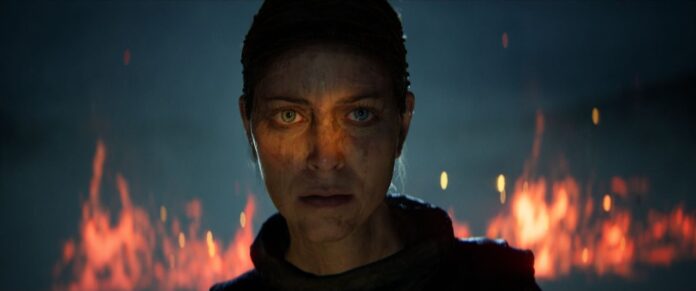
This is one of the most cinematic games I have ever played. While playing the game, there are zero UI elements to distract you. No health bar, no stamina bar, no minimap, nothing! This is to create a more immersive experience and it works. I do not miss the UI at all and the gameplay doesn’t require it. The game does a good job of guiding you from point A to point B without the need for the UI, it becomes fairly obvious when you are on the brink of death. Hellblade II feels like the primary focus is to tell the continued story of Senua in as cinematic of an experience as possible and in my opinion they nail it!
Even before the game launched, we knew that it would run at 30 frames-per-second instead of the more favorable (by many) 60fps. After playing the game, I can tell that this was deliberate and it works really well although I do wonder what it would have been like if Hellblade II actually ran at 24fps like most movies. That said, the 30fps was smooth and there was all of one time where I noticed any frame drops and it was a pretty big moment and I could see that it was somehow a problem with using the Xbox Series X’s Quick Resume feature which I feel always introduces some problem after a few days.
Another massive win for Hellblade II is the visual presentation. I don’t know enough to go into the nitty-gritty (for that I highly recommend checking out Digital Foundry’s video), but the game was absolutely stunning. It is possibly the best looking game I’ve ever played. Everything looked spectacular with the level of detail the characters and environment had as well as the lighting and movements. Even the hair looked absolutely amazing which long-time readers may know is a huge thing for me.
The audio for this game is phenomenal as well. The musical score and cues are top notch, the foley is impeccable, and the use of 3D binaural audio is fantastic for an immersive experience as Senua. This does bring up one of the first downsides of Hellblade II. The binaural audio requires you to use headphones. For PC, this is not a huge problem, but for Xbox it’s a bigger problem because the Xbox Series X/S consoles do not have Bluetooth. This means your headphone selection is smaller because you need a headset with Xbox Wireless protocol (I was lucky enough to have the Razer Kaira Pro), plug a wireless dongle into a USB port on your Xbox, or use a wired connection to the controller. It’s just more tedious than it should be in my opinion. That said, the binaural audio is totally worth it in my opinion.
I do want to note that I also appreciate the efforts Team Ninja went through to accurately portray a delicate matter such as psychosis. I have never experienced psychosis, but it felt very tasteful and that probably has to do with the homework the team did. They collaborated with Professor Paul Fletcher from the University of Cambridge as well as “people with lived experience of psychosis.”
Because Hellblade II is short (typically less than eight hours to complete), I am not going to talk about any details that I haven’t already mentioned. That said, I think it’s told very well except I still don’t know how I feel about the ending. It’s very well done, but I also felt like something was missing. I can see how the team can use that ending to jump into a third game or leave it closed with the ending presented and I’ll be interested to see what happens in the future. I really enjoyed the three companions that Senua gains across her journey and their personal story arcs.
Let’s talk about gameplay though. There are essentially three components of gameplay: walking sim, puzzles, and combat. The walking sim has nothing of note to talk about other than I found myself holding LB almost the entire time I played because otherwise you move so slow and the movement is very smooth and feels better than other games I’ve been playing on the Xbox lately like Assassin’s Creed Valhalla. The puzzles are straightforward and honestly not very difficult. The combat is not great in my opinion (for reference I had combat difficulty set to Dynamic). It feels really hard to parry attacks (but feels fantastic when you do) and even dodging feels a little clunky. There feels next to no point to having a heavy attack as the enemy almost always just blocks it or dodges it. The combat is very simple and repetitive and it doesn’t feel very rewarding other than “yay, it’s over so I can move on with the story.” I feel both the puzzles and combat are done this way to help promote the story and keep it the star. That’s fine with the puzzles in my opinion (although I would’ve liked a little more something to them) but the combat is a big bummer honestly and Hellblade II’s biggest weakness.
It’s time to recap. Hellblade II is a highly cinematic and gorgeous story focused video game. I liked my time with it a lot despite not playing the first game. It does suffer from repetitive and frankly boring combat and to get the binaural audio experience you can’t just use any old pair of bluetooth headphones. I do not believe that the 30fps lock on the Xbox Series X is any problem and do genuinely wonder what a 24fps version would be like for an even more cinematic experience. If you want to experience a game that is absolutely gorgeous to behold with an interesting story, I would recommend Hellblade II, especially if you have Xbox Game Pass since it won’t cost you any extra money. I would genuinely score this game a solid 8.5/10, but due to not having a graphic for it, we’ll round up.
Tommy Williams
Curated From geektyrant.com Check Them Out For More Content.

